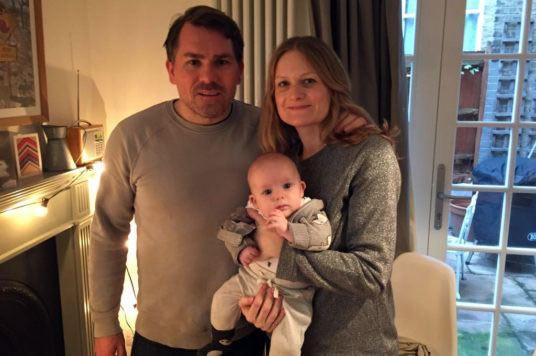UK First As Mother And Baby's Lives Saved At St George's
Doctors operated on Polly Marshall and her unborn baby

Baby Gus and his proud parents
Specialists at St George’s have operated on a woman to repair a life-threatening, large swelling in the artery supplying blood to her unborn baby.
The procedure has never been carried out on a pregnant woman in the UK before, with only one case documented worldwide, in France.
Polly Marshall, 38, from North West London, underwent the emergency procedure at St George’s last July whilst 32 weeks pregnant. It involved interventional radiologists at St George’s closing off the swelling (known as a pseudoaneurysm) in her uterine artery. The team then inserted specially designed metal coils into the artery supplying the aneurysm, preventing blood from flowing into it.
If the aneurysm had burst this could have had catastrophic consequences for both Polly and her unborn baby.
Doctors were able to access the aneurysm by inserting a fine catheter tube into the blood vessels under image guidance. This was done via a pin-sized hole in Polly’s groin using only local anaesthetic.
The operation meant that Polly was able to give birth via caesarean section in September 2017, and is now the proud mother of son Gus, aged 5months.
Polly was first admitted to St George’s after experiencing severe abdominal pain during her second trimester.
Dr Kevin Hayes, Consultant Obstetrician and Gynaecologist at St George’s, led the team which diagnosed her problem. He says, “It is extremely rare for women to develop a pseudoaneurysm whilst pregnant. Detailed scans showed that the swelling in Polly’s artery was 5cm in diameter and also getting bigger. Blood flow through this artery is particularly strong during pregnancy, so we knew doing nothing was not an option.”
Dr Hayes sought the opinion of Professor Anna-Maria Belli, Consultant Interventional Radiologist at St George’s, who agreed that occluding the blockage to restore blood flow was the only option – and that waiting until Polly gave birth would be too dangerous.
Professor Belli carried out the procedure with her team in Interventional Radiology, together with colleagues from anaesthesia and obstetrics and gynaecology – who came ready to perform an emergency caesarean section in the event the baby became distressed. Vascular surgery was on standby if needed.
Professor Belli says, “This is a significant step-forward and, without the technology and expertise we have at our disposal, Polly’s outlook would have been far, far worse.
“The fact she was able to undergo the procedure – and carry her baby to term – is a fantastic achievement, and has positive implications for other women in her position.”
Polly, who lives in North West London with her partner Mat, says, “I am so pleased with the care I received at St George’s. It was a really frightening time – particularly being admitted to hospital at such an early stage of my pregnancy.
“However, the fact that I’m here and well today, and was able to carry Gus to term, is amazing, and I will always be grateful that the problem was identified so early, and that I was looked after by real specialists. I always felt in safe hands.”
April 16, 2018